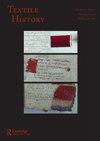“打扮成九十年代”,伯明翰博物馆和美术馆,2019年12月7日至2020年9月4日
IF 0.1
2区 社会学
0 HUMANITIES, MULTIDISCIPLINARY
引用次数: 1
摘要
这个小型但引人入胜的展览展示了从1850年到现在伯明翰及其周围场合的着装。这是伯明翰博物馆和艺术画廊最近创建的一系列展览之一,旨在邀请公众在计划翻新后帮助塑造未来的展览。一个典型的维多利亚时代的博物馆,它的核心是城市的社会历史,它的人民和工业,但已经变得陈旧和过时。希望参观者的体验和反馈将有助于塑造未来新画廊空间和展览的设计和内容。由于服装和纺织品在此之前并没有被特权作为展览的基础,这次以服装为基础的对当地历史和文化的探索是为了在未来扩大这一想法。显示器的尺寸和相当简单的设计反映了该企业的实验性质。大部分的衣服和配饰从来没有离开过储藏室。与许多社会历史博物馆一样,这些服装收藏以前只是用来支持他们的展览。有问题的是,伯明翰的服装和纺织品通常是作为装饰艺术而不是它们自己的社会历史来收集的,这往往是地区性博物馆的典型特征。可悲的是,这意味着通常很少或根本没有与服装相关的信息,这使得在规划展览时很难实现当地的背景。然而,策展人丽贝卡·昂斯沃斯(Rebecca Unsworth)利用手头有限的背景证据取得了相当大的成就,并用当地的研究补充了往往贫乏的信息,以呈现相关的、背景的故事。以一些当地的服装为基础,丰富多彩的展览探索了1850年至今当地居民、官员和商人在正式活动、聚会和夜晚外出时的不同方式。12套精心挑选的服装涵盖了多年来购物选择和习惯的一些变化,以及伯明翰社会和文化的变化。一件端庄的19世纪60年代丝绸晚礼服与一件20世纪30年代迷人的珠饰晚礼服组成了一个小展览(图1)。对面的一个更大的展览旨在展示更广泛的回顾,展示了该系列中场合着装的类型和风格,代表了几十年来当地社区的不同地区。首相内维尔·张伯伦(Neville Chamberlain)所穿的一件20世纪30年代华丽的金色刺绣宫廷礼服,以及哈特内尔(Hartnell)的妹妹所穿的一件40年代诺曼·哈特内尔(Norman Hartnell)鸡尾酒会礼服(图2)。哈特内尔的妹妹在伯明翰共同创办了一所舞蹈学校(图2)。然而,由于它是由尼龙制成的,它代表了当时市场上涌现的新型合成面料,这使得人们更能负担得起化妆。在仅有的两件男装中,第二件展出的是一位当地服装商在上世纪70年代穿的一件亮金色锦缎晚装。为了庆祝伯明翰的文化和社会多样性,一件1995年在汉兹沃斯(Handsworth)购买的美丽的红色和金色刺绣莎尔瓦卡米兹(salwar kameez)与一件1958年的黑色迪奥(Dior)现成鸡尾酒礼服和一件亮粉色的易装裙共用一个空间,这是2019年当地一家lgbt夜店的主持人穿的。一件令人瞠目结舌的当代狂欢节服装照亮了最后一个部分(图3)。伯明翰每两年戴一次集体派对帽来庆祝非洲-加勒比文化;这是2000年的一个极好的例子。这些小而生动的展览吸引了游客,引发了人们的交谈和兴趣本文章由计算机程序翻译,如有差异,请以英文原文为准。
‘Dressed to the Nines’, Birmingham Museum and Art Gallery, 7 December 2019–4 September 2020
This small but engaging exhibition presented dressing for occasions in and around Birmingham from 1850 to the present day. It was one of a series of displays created recently by Birmingham Museum and Art Gallery with the intention of inviting the public to help shape the displays of the future after planned renovations. A typical Victorian-era museum, it has at its core the social history of the city, its people and industries, but has become tired and outdated. It is hoped that visitor experience and feedback will prove valuable in helping shape the design and content of future new gallery spaces and exhibitions. As dress and textiles had not previously been privileged here as the basis of an exhibition, this clothing-based exploration of local history and culture was trialled with a view to expanding the idea in the future. The size and fairly simple design of the displays reflected the experimental nature of the enterprise. Most of the objects of dress and accessories had never been out of storage. In common with many social history museums, the dress collection had previously been used simply as support for their exhibitions. Problematically, and often typically for regional museums, dress and textiles at Birmingham were collected as decorative art rather than for their own social history. Sadly, this means that there is most often little or no information to accompany the garments, making it difficult to achieve local context when planning exhibitions. Nevertheless, curator Rebecca Unsworth achieved a fair amount with the limited contextual evidence to hand, supplementing often meagre information with local research to present relevant, contextual storytelling. Using as a basis for the displays garments with some local provenance, the colourful exhibition explored the different ways local residents, officials and business people presented themselves for formal functions, parties and nights out on the town from 1850 to the present day. Twelve carefully chosen outfits covered some of the ways shopping choices and habits have changed over the years, along with social and cultural changes in Birmingham. A demure 1860s silk evening dress made a small display with a glamorous 1930s beaded evening dress worn to a banquet by a lady mayoress (Fig. 1). A larger display opposite aimed to illustrate a broader retrospective of the types and styles of occasion wear from the collection, representing different areas of the local community over the decades. A spectacular gold embroidered 1930s court dress uniform, worn by Prime Minister Neville Chamberlain, was presented in conjunction with a 1940s Norman Hartnell cocktail dress worn by Hartnell’s sister, who co-founded a dance school in Birmingham (Fig. 2). A 1959 party dress was sadly the only representation of children’s clothing. However, as it was made from nylon it represented the new synthetic fabrics bursting onto the market of the period that made dressing-up more affordable. A bright gold brocade evening jacket worn by a local outfitter in the 1970s was the second of only two menswear garments on display. Celebrating the cultural and social diversity of Birmingham, a beautiful red and gold embroidered 1995 salwar kameez, bought in Handsworth, shared space with a black 1958 Dior ready-towear cocktail dress and a bright pink drag dress worn by the host of a local LGBTQþnightclub in 2019. An eyepopping contemporary carnival costume lit up the final section (Fig. 3). Birmingham celebrates African-Caribbean culture biannually by putting on its collective party hat; this was a fabulous example from the event in 2000. The small but lively displays engaged the visitor, prompting conversations and
求助全文
通过发布文献求助,成功后即可免费获取论文全文。
去求助
来源期刊

TEXTILE HISTORY
HUMANITIES, MULTIDISCIPLINARY-
CiteScore
1.00
自引率
0.00%
发文量
0
期刊介绍:
Textile History is an internationally recognised, peer reviewed journal and one of the leading publications in its field. It is viewed as an important outlet for current research. Published in the spring and autumn of each year, its remit has always been to facilitate the publication of high-quality research and discussion in all aspects of scholarship arising from the history of textiles and dress. Since its foundation the scope of the journal has been substantially expanded to include articles dealing with aspects of the cultural and social history of apparel and textiles, as well as issues arising from the exhibition, preservation and interpretation of historic textiles or clothing.
 求助内容:
求助内容: 应助结果提醒方式:
应助结果提醒方式:


